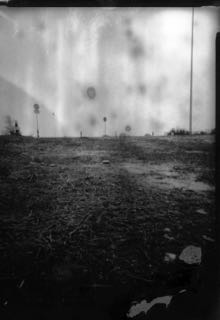These dark and moody photographs were made at the docks at the new building area “Überseestadt” in the north of the City of Bremen, Germany and the harbor of Brake, Germany. Jan would head there after throwing his clothes in at the laundromat. Having time to kill, he would arrange his pinhole cameras there even in the most miserable of conditions. Most of us wouldn’t bother to set out cameras in a huge storm, however Jan was pleasantly surprised in the way that some photos came out spectacularly in that they conveyed more about the storms than they did about the scene.
“I think [the pictures] are more “whole”, because they show not only the physics of light, but -by accident- even the physics of humidity or even wetness chemically reacting with the photo-sensitve paper in the camera (add to it the poor developement technique and its imprints on the negative they became in a “Berthold Brecht Way” epical).”
Photos 1 – 3
Jan set up his camera in a heavy downpour, and then waited in his car with a beer and the radio on for about 15 minutes while making the exposure on Ilford multigrade paper. During the exposure, the rain became even heavier, and a thunderstorm started, before he left his car again to retrieve the cameras. The wood box cameras had become soaked through. He headed for home, grabbing his laundry on the way, to develop the paper negatives.
On #1 there were some sprinkles of water from the rain that got in the camera. The uneven sky, water stains, and dark foreground bring the stormy situation together.
#1
[singlepic id=44 w=400]#1, ©Jan Geisen 2015[/singlepic]
Photo #2 was taken by a camera placed underneath a small dock for yachts. This camera also had some water issues, causing parts of the image to be brightened, reminiscent of the lightning of the storm. As luck would have it, the water stains add to the linear feel of this image and help with the contrast. The lasting impression is of the moody, violent storm that had washed through during the exposure.
#2
[singlepic id=45 w=400]#2, ©Jan Geisen 2015[/singlepic]
The camera for #3 takes in the broader scene that was detailed in photos #1 and #2, and it too took in rainwater. Again we see more of the staining and bright streaks that were shown in the previous photos. The distant buildings are softened by the rain, and one feels the blanketing of this storm.
#3
[singlepic id=46 w=400]#3, ©Jan Geisen 2015[/singlepic]
Jan returned to the scene another time for #4, this time under different weather conditions. He set up the camera under sunny conditions, but in the distance there were dark clouds forming for another storm. The exposure was just a few minutes, but in that time the weather had turned measurably worse, and Jan collected his camera just as the heavy rains moved in on him.
#4
[singlepic id=47]#4, ©Jan Geisen 2015[/singlepic]
Now in photo #5, Jan set up to capture another perspective – this time at the harbor of Brake, a town near Bremen – and again, the storms came too. But unlike in #5, Jan wasn’t as lucky with his timing. Just as Jan started the exposure, the hardest rains yet soaked him through, and again he waited in his car for 15 minutes during the exposure. When he did retrieve his camera, he found it face down in the mud. The final image being very dark and foreboding, with but a streak of light in the middle to give a tease of what he came for.
#5
[singlepic id=48 w=400]#5, ©Jan Geisen 2015[/singlepic]

